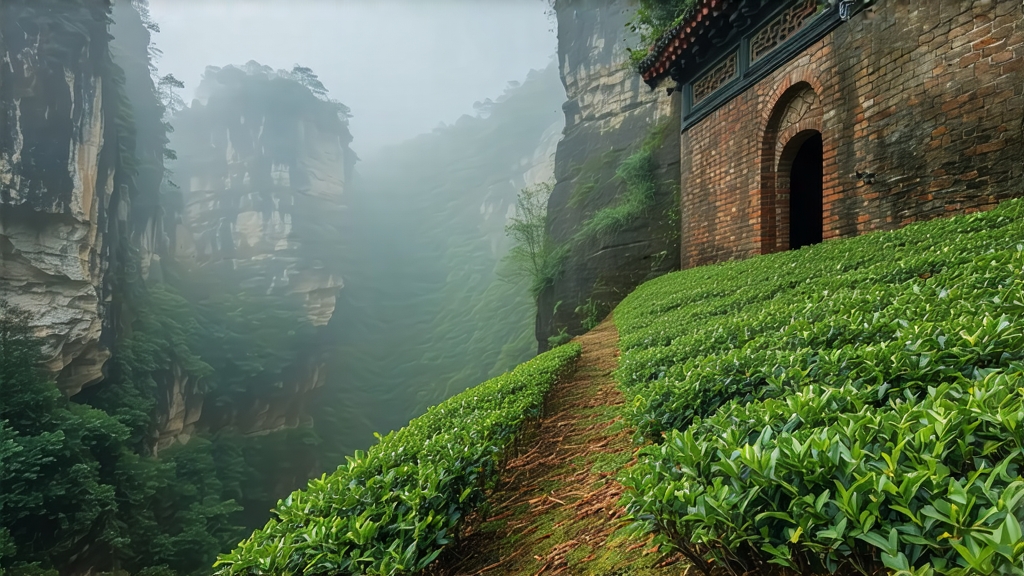
If green tea is the fresh-faced youth of Chinese tea and pu-erh the wise elder, then Da Hong Pao—literally “Big Red Robe”—is the charismatic middle-aged monarch who strides into the room wearing a scarlet cloak scented with stone, orchid and smoke. Hailing from the vertiginous Wuyi Mountains of northern Fujian, this rock oolong (yancha) carries within its twisted, obsidian-dark leaves a thousand years of Song-dynasty poetry, Ming-era imperial legend, and the quiet footfalls of monks who once lowered themselves over cliffs on rope ladders to harvest it. To drink Da Hong Pao is to taste the mineral marrow of China’s most mythic terroir.
Historical whispers begin in the early 14th century, when a Ming emperor’s mother was allegedly cured of illness by a few crimson-sashed tea branches plucked from the Wuyi’s Niulan (“Cow Pen”) ravine. In gratitude the sovereign sent his own scarlet imperial robe to drape the mother bushes, declaring them sacred. Whether apocryphal or not, four ancient bushes still survive on a narrow ledge above the Nine-Dragon Gorge, their gnarled trunks older than Shakespeare and now protected by cameras, armed guards and a multi-million-yuan insurance policy. Cuttings taken in the 1980s through asexual propagation (wanzai qiangzhi) created the “purebred” or qizhong Da Hong Pao now cultivated across 4,000 hectares of the Wuyi core scenic zone, while blends of selected yancha cultivars (often Shui Xian, Rou Gui, Qi Dan and Bei Dou) supply the more affordable commercial grades that carry the famous name.
Terroir is everything. The Wuyi’s Danxia landform—purple-red sandstone and white quartzite—weathers into a shallow, fast-draining soil laced with iron and potassium. Mist rising from the Nine-Bend River moderates temperature, extending the growing season and forcing the bushes to send roots deeper, drawing up minerals that translate into the celebrated “rock rhyme” (yanyun): a tactile, almost tactile-lithic sensation that Chinese tasters describe as “sweet aftertaste climbing like a monkey up the back of the throat.” Elevations between 200 and 800 meters, combined with diurnal swings of 15 °C, concentrate aromatic precursors while keeping tannins in polite check.
Plucking occurs only in late April to early May, when two leaves and a bud have fanned open to the size of a sparrow’s tongue. The harvest must finish before the arrival of the southern monsoon; rain-drenched leaves lose their ability to oxidize evenly. Once picked, the foliage is spread on bamboo trays and withered under the mountain sun for 30–45 minutes, turned every ten minutes to ensure uniform moisture loss. The goal is to reduce grassiness while coaxing out a faint apple-skin note that will later marry with charcoal fire.
Indoor withering follows in a climate-controlled room kept at 24 °C and 65 % humidity. Here the leaves are alternately shaken in rattan drums and allowed to rest—up to eight cycles across the night—in a ritual called zuoqing, “making green.” Each toss bruises the leaf edges, triggering enzymatic oxidation that migrates inward at roughly 1 mm per hour. A master will press a leaf between thumb and forefinger: when the central vein turns translucent yet the margins remain copper-green, oxidation is arrested. For Da Hong Pao this sweet spot hovers around 40 %—halfway between the 8 % of green tea and the 70 % of black.
Shaqing, or “killing the green,” is done in a 200 °C drum roaster for exactly seven minutes, hot enough to denature polyphenol oxidase but brief enough to preserve floral volatiles. Next comes rolling: the hot leaves are wrapped in canvas and kneaded under a mechanical arm that twists them into the traditional strip shape, rupturing cell walls so that oils and sap mingle. After a short re-drying, the semi-finished maocha is sorted by size and stored for three weeks to “calm the fire,” allowing residual moisture to equalize before the defining Wuyi process—charcoal roasting.
Rock oolong is baked over a dying ember of local hardwood, usually longan or lychee, whose slow-release heat perfumes the leaf. The firing proceeds in three